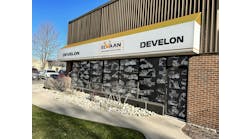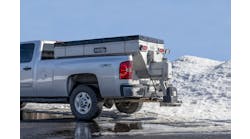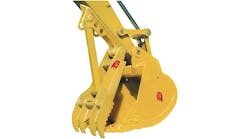For customers unfamiliar with large equipment, some companies offer rentals with Operators Included By Mike Bredl
Consider them heavy equipment contractors.
Even with heavy pressure on rates, some heavy equipment rental firms are thriving, largely because clients can rent more than just the excavator, crane or dozer: The operator comes as part of the package.
The concept is not new, and indications are it won't go away. With skilled operators increasingly difficult to find, the option to rent from a company that has a stable of heavy equipment experts is attractive.
One of the largest operator providers is Penhall Rentals, a concrete sawing and breaking equipment business in Santa Ana, Calif., with locations in 13 states as far east as Georgia and as far north as Minnesota. Another, Pittsburgh-based Maxim Crane Works, No. 25 in the RER 100 with estimated 1999 rental revenue of $39 million, offers equipment and operator rental from 30 centers coast to coast.
Operators for rent? Equipment rental companies that offer operators typically focus on machines such as large excavators, bulldozers, off-highway trucks and cranes - items not typically offered by general rental firms. Competition for those larger pieces of equipment comes primarily from other companies and dealers in the same business, not the household names in the operator-free segment of the rental industry.
Ecco Equipment, another Santa Ana-based rental firm with branches in Arizona, California and Nevada, offers large Caterpillar products, including D10 dozers and 988 loaders - machines that smaller contractors might not be comfortable operating.
There are other reasons for letting someone else do the work.
Maxim, for example, won't rent some of its larger equipment without an operator, dispatcher Bob Torreti says. The company's rough-terrain cranes are available in 90-ton capacities and require the skill of a certified operator.
Part of Ecco's attraction to contractors is the operator.
"Sometimes it's easier for us to get an operator," company president Don Schmid says. "[Contractors] may know how to use the equipment, but they don't have enough operators and may not know where to find one. That's where we come in."
The operators usually are employed by the rental firm. They receive their checks from the rental company, but once a client has rented the equipment, they essentially are employees of the client until the job is complete.
Cost and training Most heavy equipment rental companies that offer operators give the client the choice to rent the equipment with or without them.
Choosing the former obviously costs more. At Ecco, for instance, Schmid says the cost can be double that of renting without an operator. Depending on the equipment, he says the price generally is $40-$50 an hour more plus the fuel costs of getting the operator to the job site.
Heavy equipment operators come to rental centers from across the country and from a variety of backgrounds.
John Sawyer, president of Penhall Rentals, says many Penhall operators used small machines before graduating to larger equipment. Schmid says the majority of Ecco operators are local and are familiar with the conditions of the area in which they work.
Regardless of the amount or quality of operator experience, heavy equipment rental companies stress safety.
All Maxim crane operators are certified, having passed written tests and demonstrated their skills at the controls. Ecco will not allow its operators to perform job-site tasks they think are unsafe or with which they are not comfortable. The company also requires its operators to attend safety meetings at the job site before turning on a machine's ignition.
And to protect the client, operators are covered by workers compensation insurance. The client assumes no liability once work has begun, Sawyer says.
A human element Heavy equipment rental firms pride themselves on offering services that most rental centers offering smaller equipment can't provide.
Heavy equipment is not a cheap undertaking. Huge capital outlays are required to get the business off the ground. It also has high overhead and requires additional investment in new machinery and operator salaries as a company grows. But despite the huge, often threatening size of the equipment, the human element is arguably its greatest strength.
"It really is quite a different business compared to most rental equipment firms," Sawyer says, noting Penhall employs 700 to 800 equipment operators nationwide. "It's much more of a people business.
"You have a lot more people to deal with, and you're not just dealing with getting a machine to the job site. You have a much larger payroll and a lot more people to satisfy."
Contractors rent large equipment with operators because
- They're uncomfortable operating the equipment or unsure how to operate it.
- There's a shortage of skilled operators.
- They want the expertise of trained professionals.
- They don't want the liability of using it themselves.
- Some machines require certified operators.
Komatsu
The BR500JG-1A mobile crusher was designed for severe crushing applications but can be used for highway construction, quarry and excavation applications, Komatsu says. Powered by a 306-horsepower diesel engine, the crusher features a hydraulic motor at each end, increasing the durability of the drive system. Other features include a 30-by-42-inch K series quarry-style jaw, a remote-control grizzly feeder with an emergency stop function and a configuration designed to reduce labor during component detachment. www.komatsuamerica.com
Caterpillar
The M312 and M315 (pictured) are recent additions to Caterpillar's line of wheel excavators. The units feature travel up to 21 mph, feature two-speed transmissions and offer a variety of boom and stick combinations. The M315 has a 114-horsepower Cat 3054 TA engine, three boom options, four stick lengths, a maximum reach of 31 feet, 3 inches and a maximum digging depth of 20 feet, 7 inches. Available attachments include buckets, quick couplers, grapples, hydraulic hammers, shears and pulverizers. www.cat.com
John Deere
The 324H four-wheel-drive loader is the newest addition to John Deere Construction Equipment's H-Series line of wheel loaders. The 15,000-pound loader features an 80-horsepower Powertech engine and stereo steering that combines articulation with rear-axle steering for the shortest turning radius in the loader's class, according to the manufacturer. The unit also features a choice of a mechanical or hydraulic coupler to handle a variety of attachments. www.deere.com
Gradall
The XL 3100 excavator, which replaces the G3WD, features high-pressure, load-sensing hydraulics that automatically adjust to the job at hand, Gradall says. The unit's Cummins ISB-190 diesel engine delivers 195 horsepower at 2,400 rpm. The boom rotates 180 degrees and can accommodate a variety of attachments. Standard features include a removable front window, a skylight, joystick controls and gauges to monitor unit functions. www.gradall.com
Case
The multitasking 621C wheel loader can be used for applications such as stockpiling, dumping into high-sided trucks and hoppers or stacking hay bales, according to Case. The 130-horsepower unit has a breakout force of 26,311 pounds and a proportional-shift transmission that features manual, automatic and custom-program modes. The unit has a straight-tipping load capacity of 20,696 pounds and a bucket capacity of 2.75 cubic yards. www.casece.com


